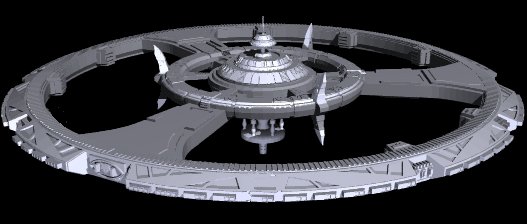

4,000 ft. diameter
60 sectors; 5 floors each; 50 apts/floor.
The Habitat Ring contains the housing sectors for the residents of the Simon Magus, and being the outermost portion of the station, also the shuttle bays. The ring is divided by six shuttle bays, three on the corridors for incoming shipments, and three with warehouses for exports. Moving walkways are provided along the sides of the corridors and around the Habitat Ring for the elderly and the injured.
Residences:
Our first concern in the design of this new city was the dehumanising aspect of design styles normally used in the construction of extraterrestrial facilities. Aboard the Simon Magus, we have tried to make everything more human sized; our doors are seven feet tall, except in areas in which large constructs must pass, and none of our residential ceilings exceed ten feet. The 4,000 ft. diameter station contains 15,000 1,500-ft2 apartments in sixty sectors which can easily be configured for comfort to the specifications of our residents. The implication that all residents will share rooms with other residents, is, for the most part, an accurate one. However, due to the fact that we expect a small number of families with children, some independent living arrangements can be made. The apartments will never be more than 3,000 feet from a corridor containing community facilities,
like medical bays, postal relays, community dining, and security stations. Because the structural materials used in the Simon Magus are neither inert nor static, neither is the internal structure of the station. The nanotech-derived materials of which the station is constructed internally are essentially as much software as they are hardware, and thus are extremely malleable and easily customized. The look and feel of anything from a Victorian mansion to a 20th century science fiction television series may be reproduced with ease. The shape, texture and color of spaces within the station are limited only by size constraints and the creativity of those who reside here. For more images of customized apartments, click here.
Shuttle bays:
Shuttle bays exist for transportation of materials and personnel to and from both ground-based and space-based locations. Groundline Industries utilizes two types of shuttles, one for long-range surface to orbit transport, and another for intraorbital transport. Both types are described below.
GroundLine Industries AstroBus
Dimensions
Length : 7.32 mMass 5,450 kgCrew 1 or 2; total capacity 8Expected Hull Life 16 yearsRefit Cycle Minor : 1 year |
The AstroBus is a simple, boxlike shuttle intended for short range space travel, as that between the IZS Simon Magus and its zero-gravity labs. The shuttle's construction is not intended for planetary missions, as it has surrendered all pretenses of aerodynamic design in favor of increased seating space. Unfortunately, squared edges make for a shorter hull life, due to increased strain from internal atmosperic pressure. |
GroundLine Industries Star Camel
Dimensions
Length : 11.37 mMass 17,120 kgCrew 1 - 4Expected Hull Life 60 yearsRefit Cycle Minor : 1 year |
 The Star Camel is a surface to orbit transport craft made for shipping goods to and from our terrestrial facilities. It makes use of a hypersonic transport as a reuseable booster stage. The Camel, like all GroundLine Industries transports, is made of high quality asteroid steel, and can withstand any sub-light speed. |